Property Development Feasibility Study Report
Executive Summary
- The proposed site is located in Huxi CBD, SIP, Suzhou, with advanced transport systems, completed infrastructures and qualified services. The land use is mixed with commercial, residential (serviced apartment) and public services.
- According to the market research results, the overall property markets in Suzhou have become saturated, especially in SIP. Residential housing as a rigid demand for citizens still has a space for development, while office building and commercial area are oversupplied. However, Huxi CBD seems to keep a favourable position in the market with high property value because of the agglomeration effect of office buildings and commercial centres.
- Legal and regulatory analysis are conducted in national and provincial levels in the aspects of land administration, construction permit, real estate and environmental protection. Then, the key documents of development regulations are summarised. All the policies and regulations should be followed strictly in order to avoid potential risks.
- Based on market research, legal and regulatory analysis, the layout and functions of proposed project have been designed to maximise the profits. Serviced apartment as the most promising market will be developed up to 30%. Then, office building will be the focus of development and commercial areas as service.
- In terms of operation, commercial areas will be leased in long term because of regulation and high rental yield. It should be positioned clearly and focus on brand building. Office building and serviced apartment will adopt the form of both rent and sales.
- Financial appraisal indicates that the developer’s profit of proposed plan is ¥ ¥2,446,961,169, 85.62% of total development cost, which is a huge profit. According to sensitivity analysis, sales price of office building and serviced apartment, and construction cost are the most sensitive factors, while the overall risk resistance capacity of the project is extremely strong. Therefore, the proposed development is viable and profitable to undertake.
01 Project Overview
1.1 Project Brief
The site (No. 2018-02), purchased via public bidding by China Vanke Co., Ltd. in June 2018, is located in the Huxi CBD of Suzhou Industrial Park (SIP), to the north of Suhui Road and east of Xinghai Road. The land use right is mixed with commercial type, residential type and public services. The overall information is shown in Table 1:
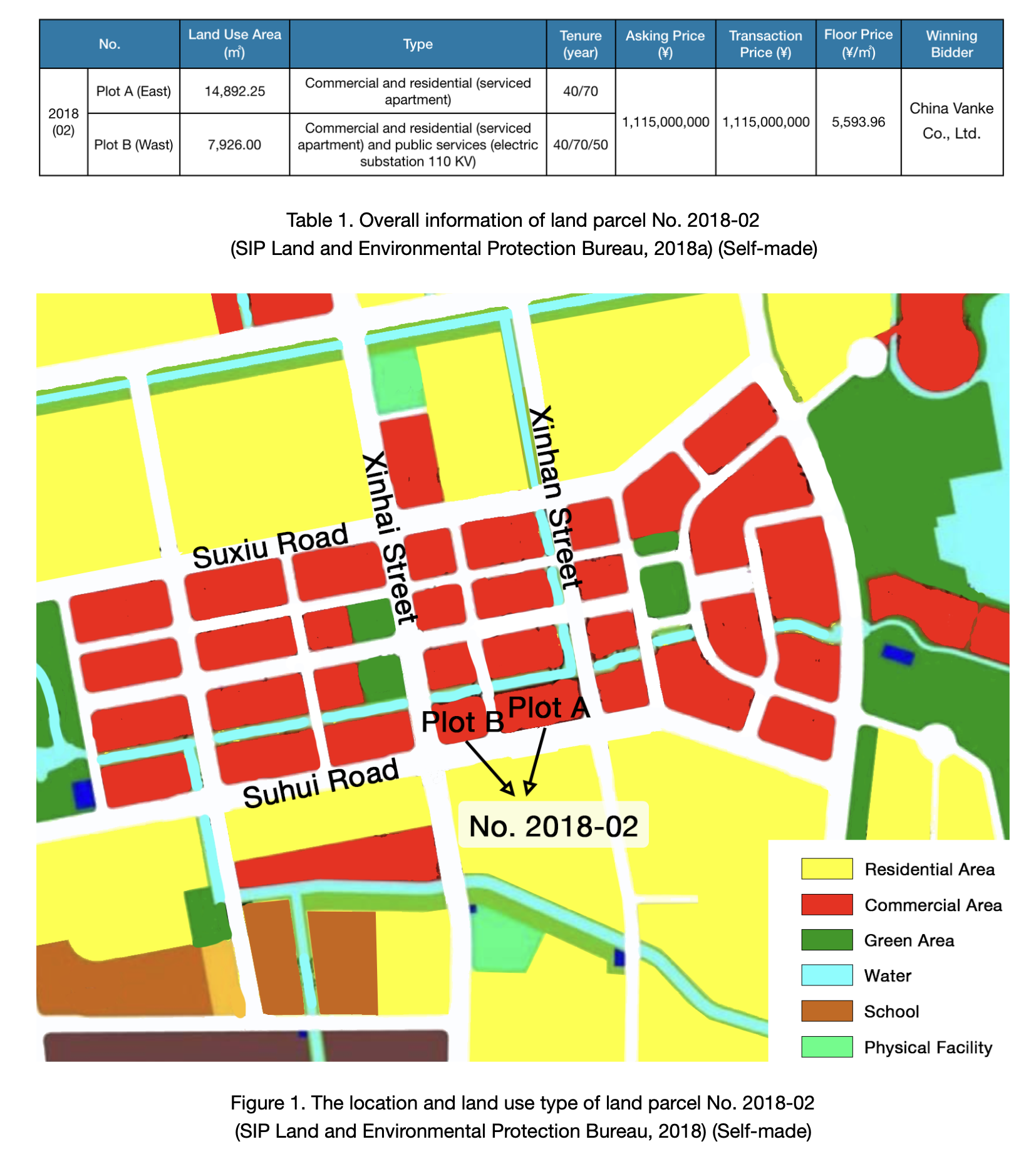
1.2 Site Description
The site is located on the west side of Jinji Lake, where is one of the most prosperous districts in Suzhou, aggregated with office buildings, high-end apartments, business and commercial centres. The traffic system is convenient with both high-speed roads and public transport facilities, including Suzhou Rail Transit Line 1 and Line 3 (expected to open in December 2019) , rich bus stations and shared bikes stops (Figure 2, 3). The infrastructures and services are complete and qualified, such as commercial centres, landscape resources and schools, shown in Figure 4.
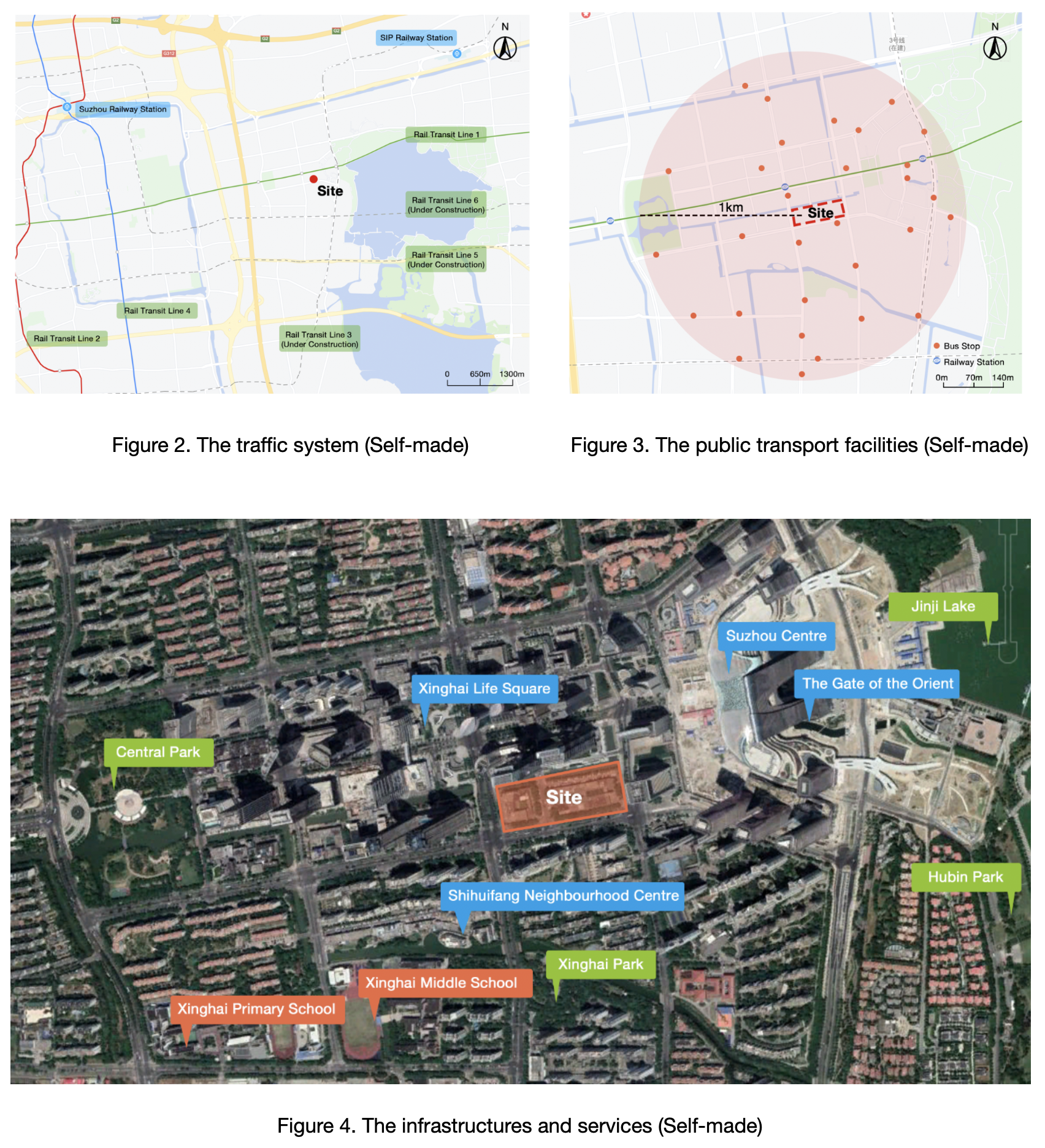
1.3 Site History
Before the adjustment of land utilization, the site was called Zuo’an Commercial Street developed by China-Singapore Suzhou Industrial Park Development Group Co., Ltd. in 2003 (Suzhou Press Conference, 2017). Due to lack of commercial services in SIP at that time, the emergency of Zuo’an Commercial Street led to a booming commercial development in Huxi District. However, with the establishment of those famous large-scale commercial centres and landmarks, such as Xinghai Square and Suzhou Centre, Zuo’an Commercial Street was gradually declined and was finally demolished in 2018 (CUTV, 2018).
02 Market Research
2.1 Overview of Property Market
2.1.1 Property Market in Suzhou
Economic Context
Suzhou has strong economic strength with the gross development product (GDP) ranked seventh in China. The GDP is increasing sustainably in the last ten years, though the growth rate is slow down (Figure 5).
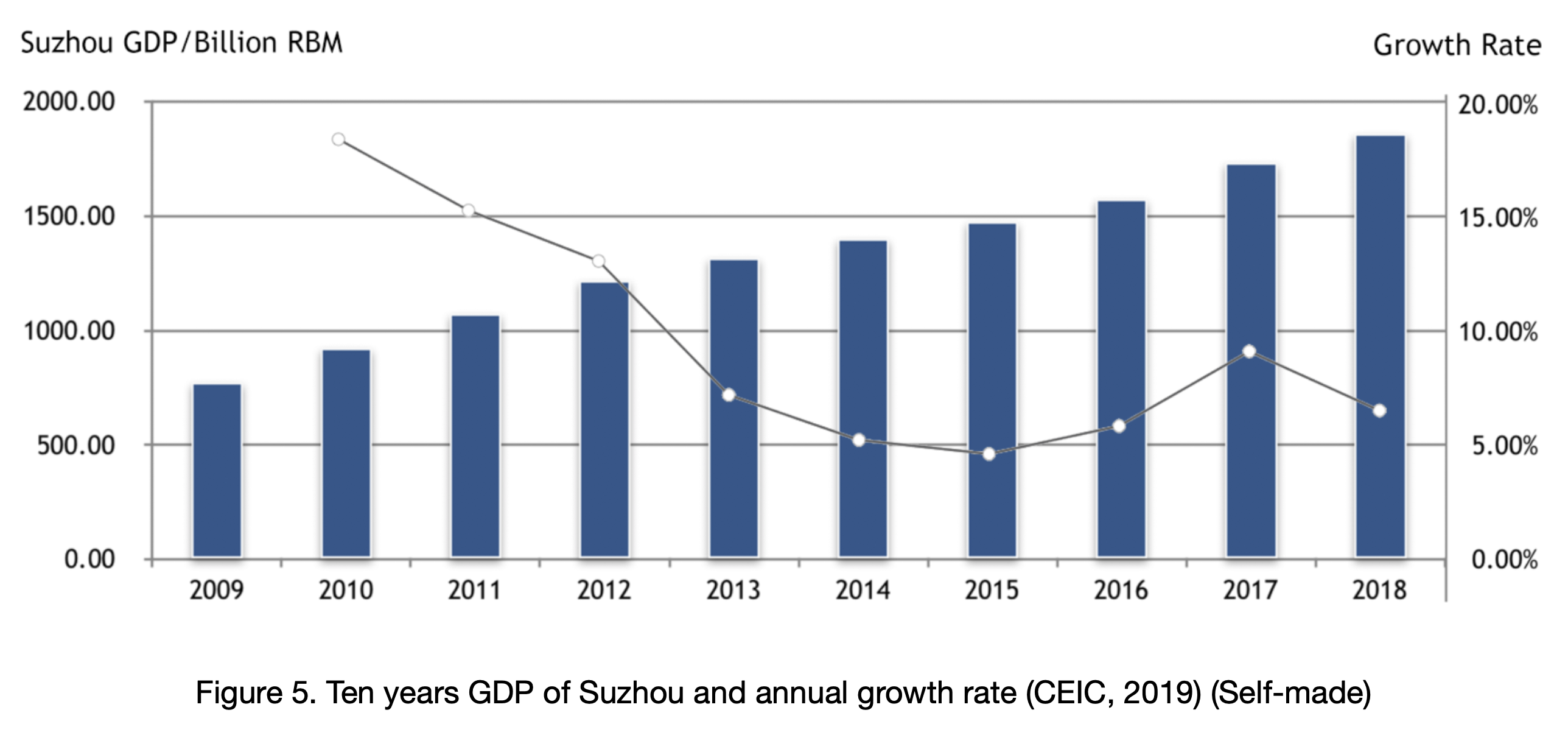
Property investment
The total property investment in Suzhou is growing with a fluctuation, which tends to be steady at around ten percent (Figure 6).
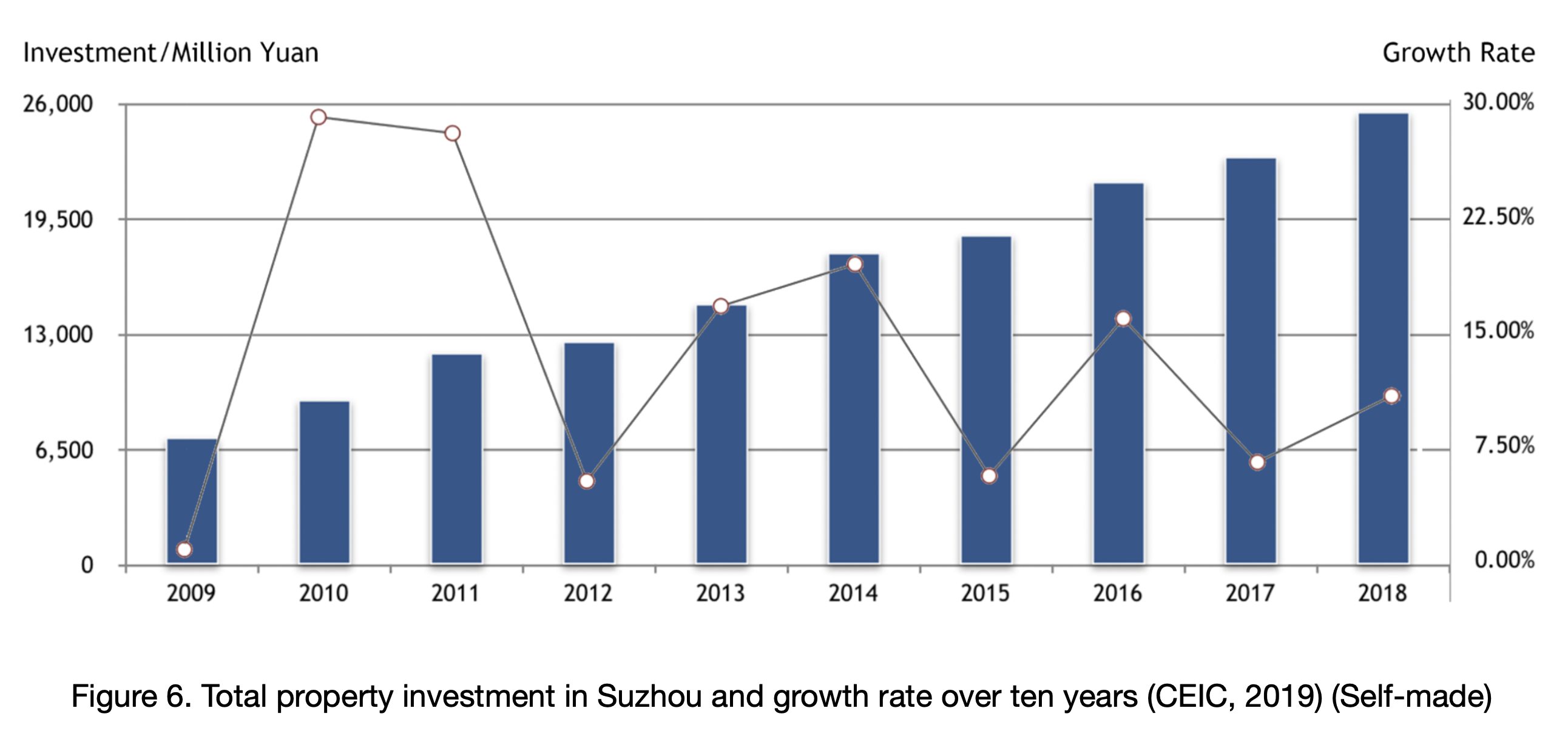
Housing Market
The supply falls short of demand after 2014 and the housing price was increasing dramatically, especially from 2016 to 2017 (Figure 7). However, the housing market tends to be cool down due to both policies and market forces (China Index Academy, 2019).
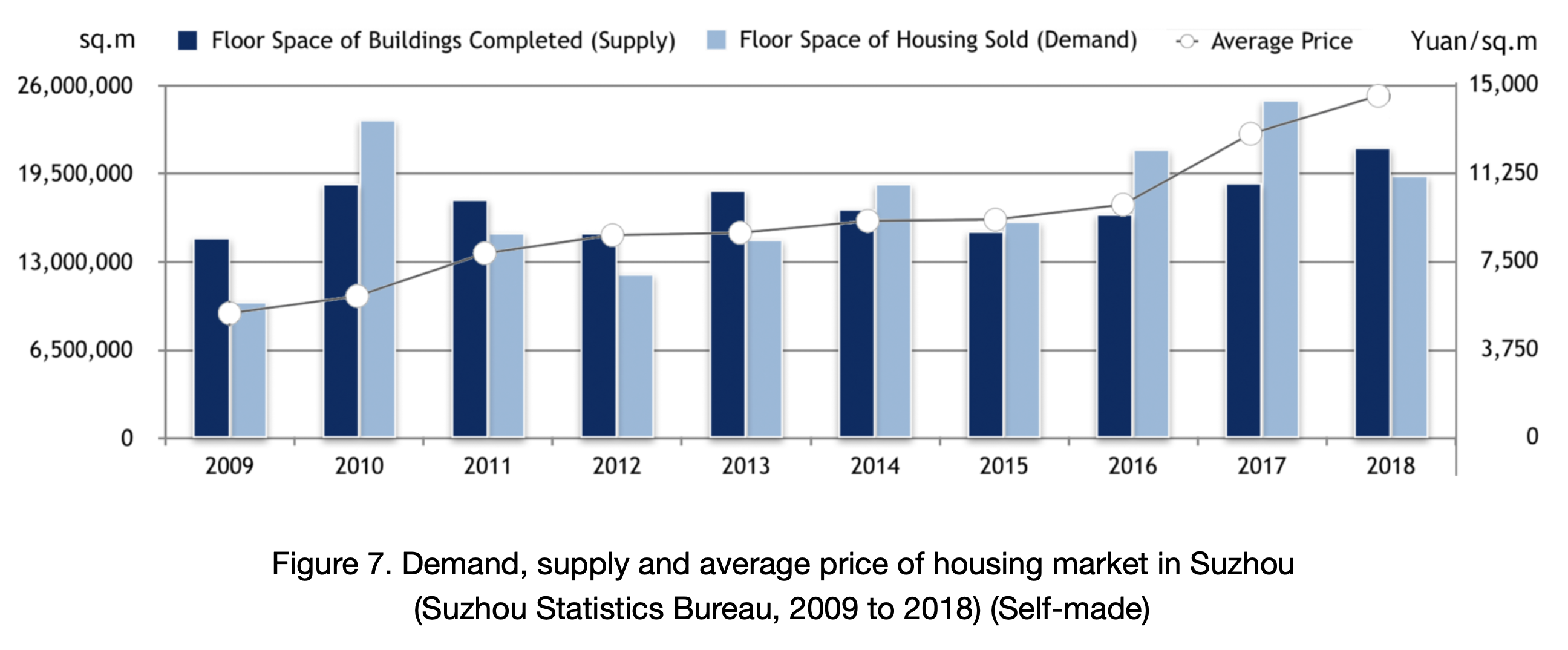
2.2.2 Property Market in SIP
Property Investment
The total property investment in SIP was decreasing after 2014, while it was rising again in 2018 (Figure 8).
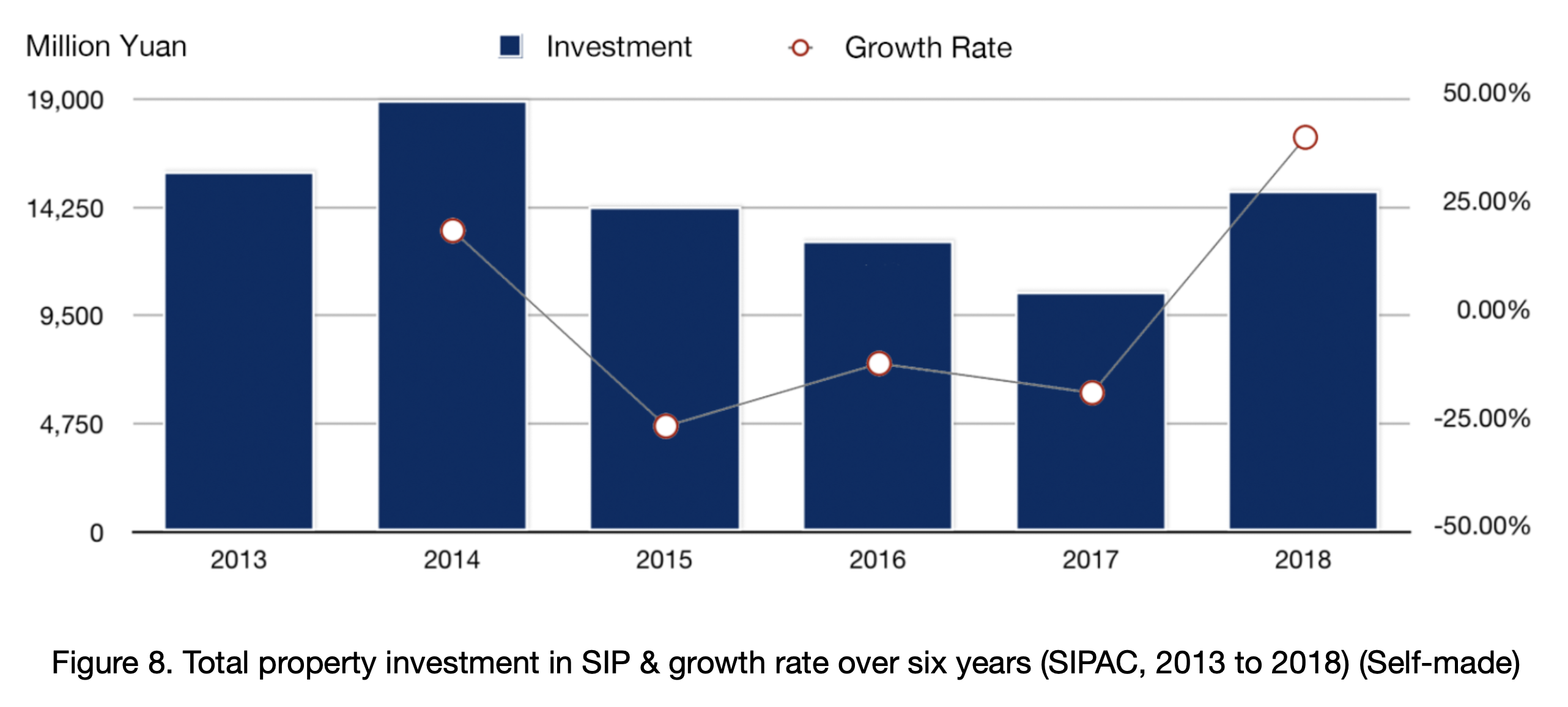
Housing Market
The supply in SIP housing market is exceeding demand for a long period of time (Figure 9). When the gap was reduced in 2015, the housing price then had a significant rise. After 2016, the average prize is decreasing and the gap between supply and demand is reducing again.
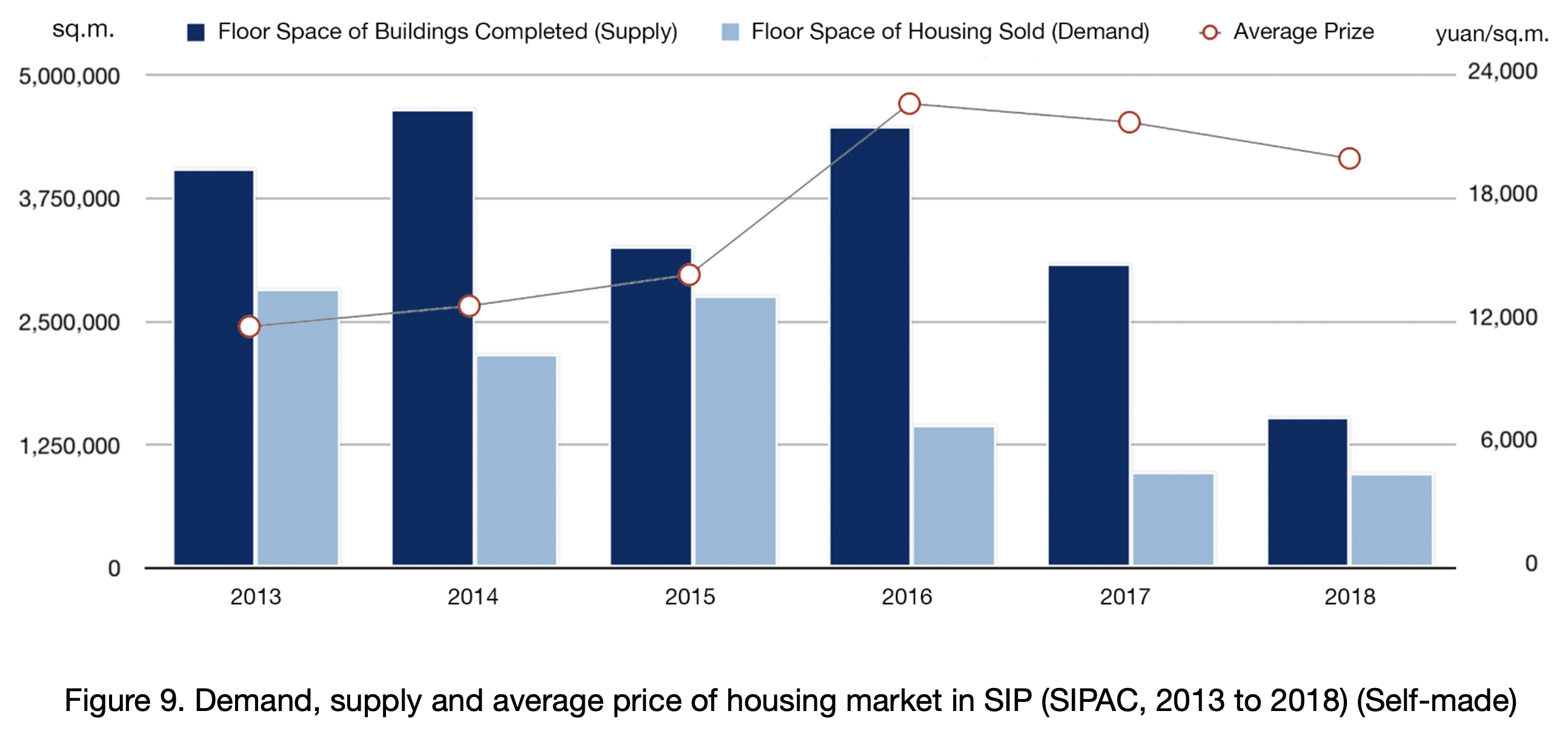
2.2 Sub-market Analysis
2.2.1 Residential Market
Figure 10 shows the overall residential market in Suzhou, which indicates that the residential housing as a rigid demand for citizens still has a space for development. As a booming year in 2016, the housing price rose significantly by 32%, while the trading volume then declined by a quarter in 2017.
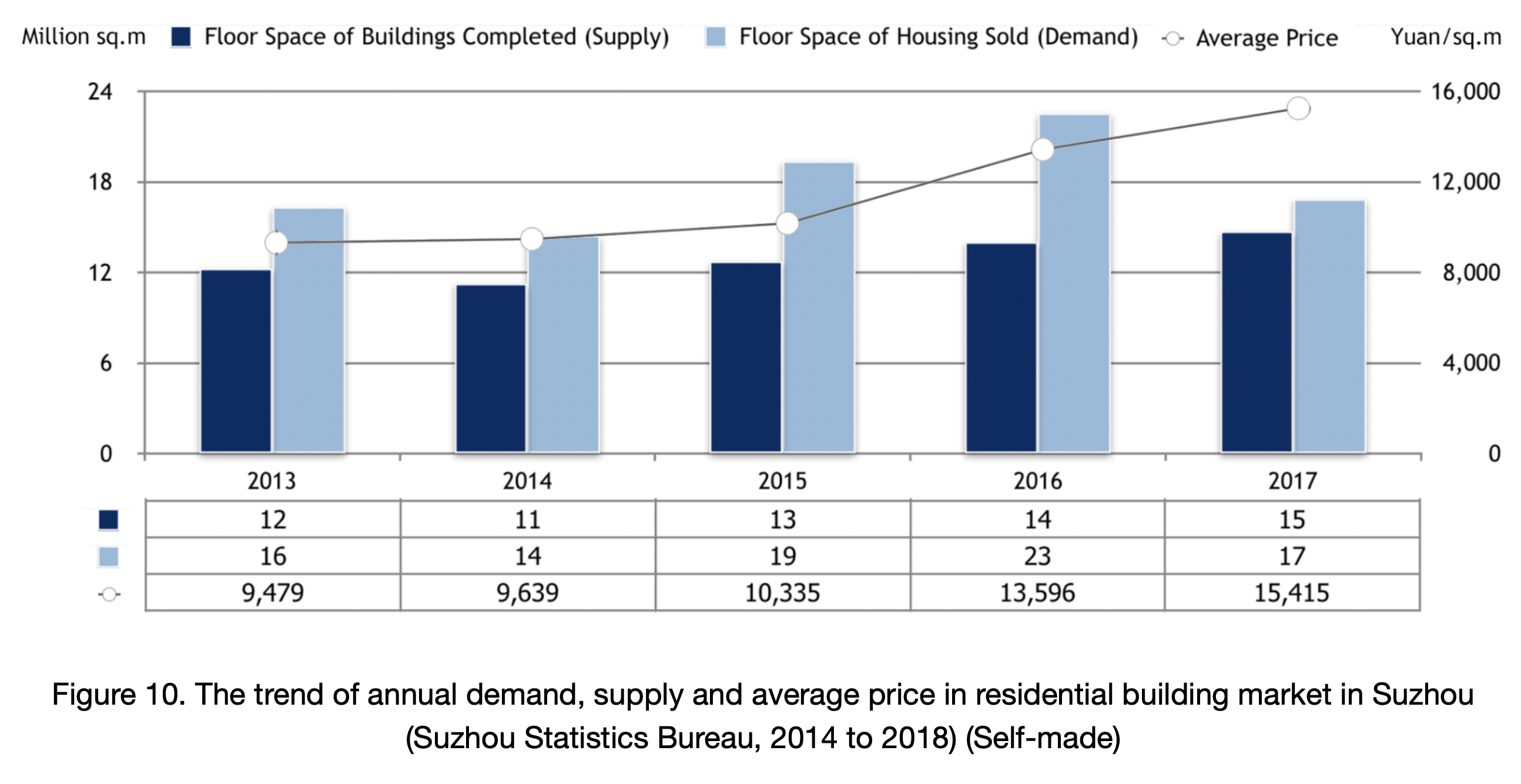
In contrast to the whole city, SIP as the most developed district in Suzhou, the supply of residential housing is beyond the requirements, but the gap is narrowing (Figure 11).
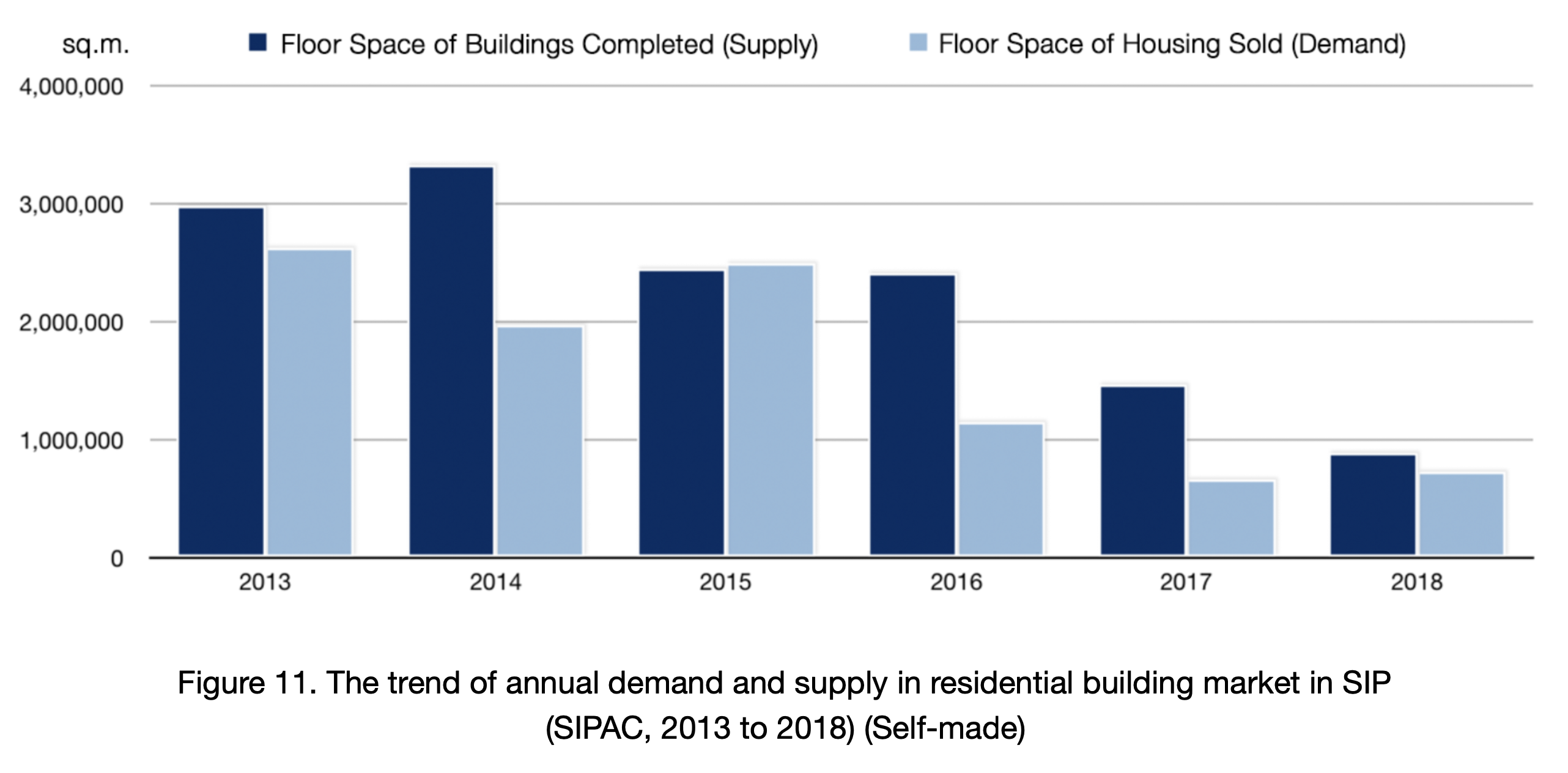
2.2.2 Commercial and Office Market
The commercial property market in Suzhou is saturated with a widening gap between supply and demand (Figure 12).
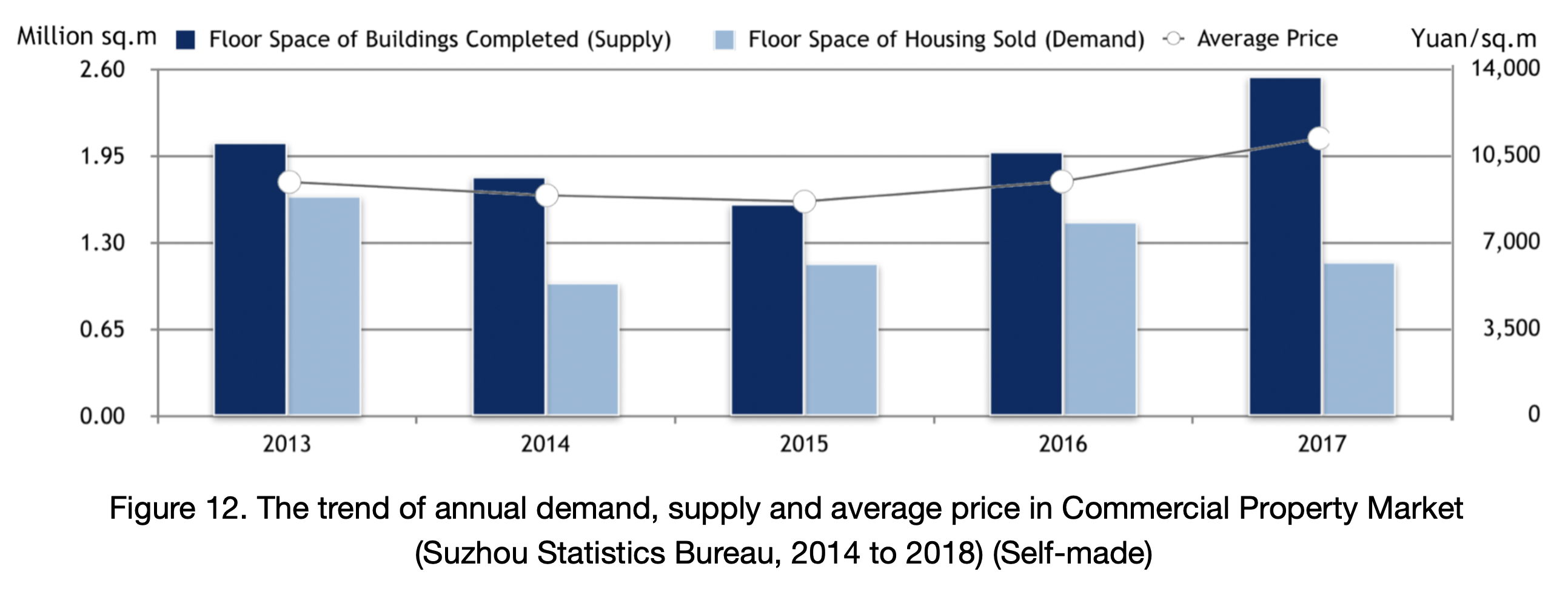
The office building market in Suzhou had a booming in 2017, while it tends to be oversupplied in the following years (Figure 13).
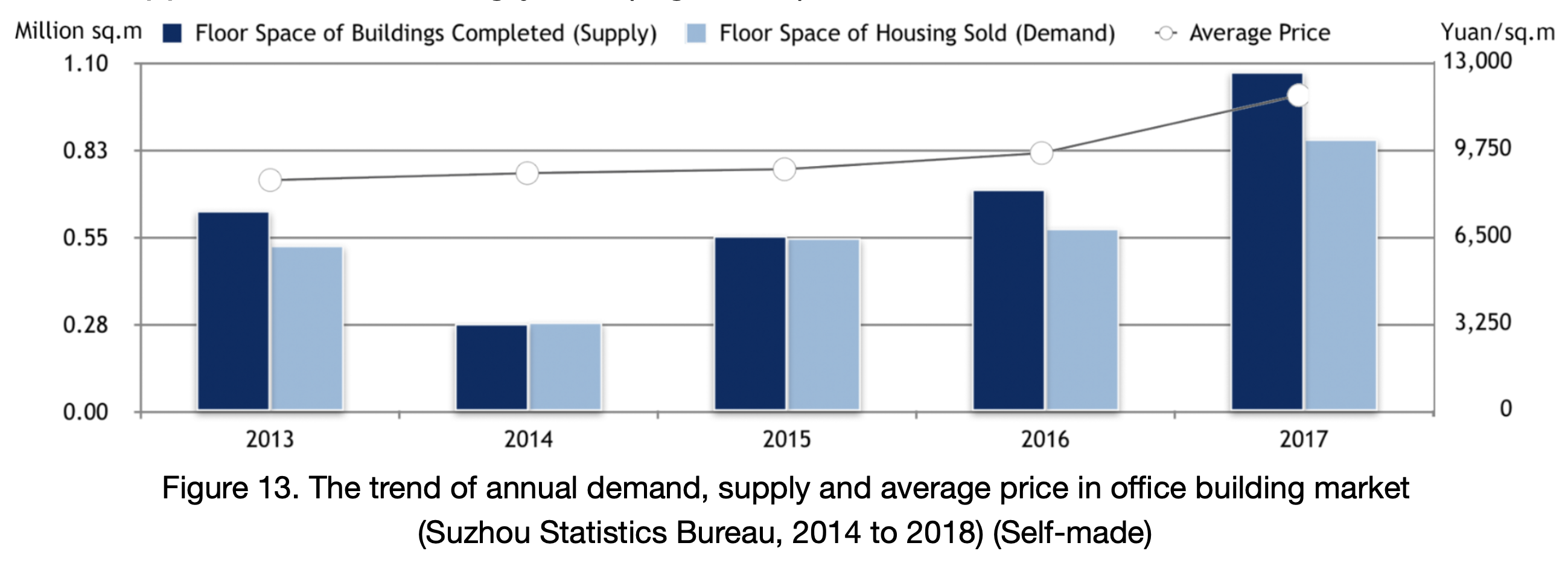
The phenomenon of over saturated commercial and office markets is extremely obvious in SIP. The supply-demand ratio was even more than 6.5 in 2016 (Figure 14).
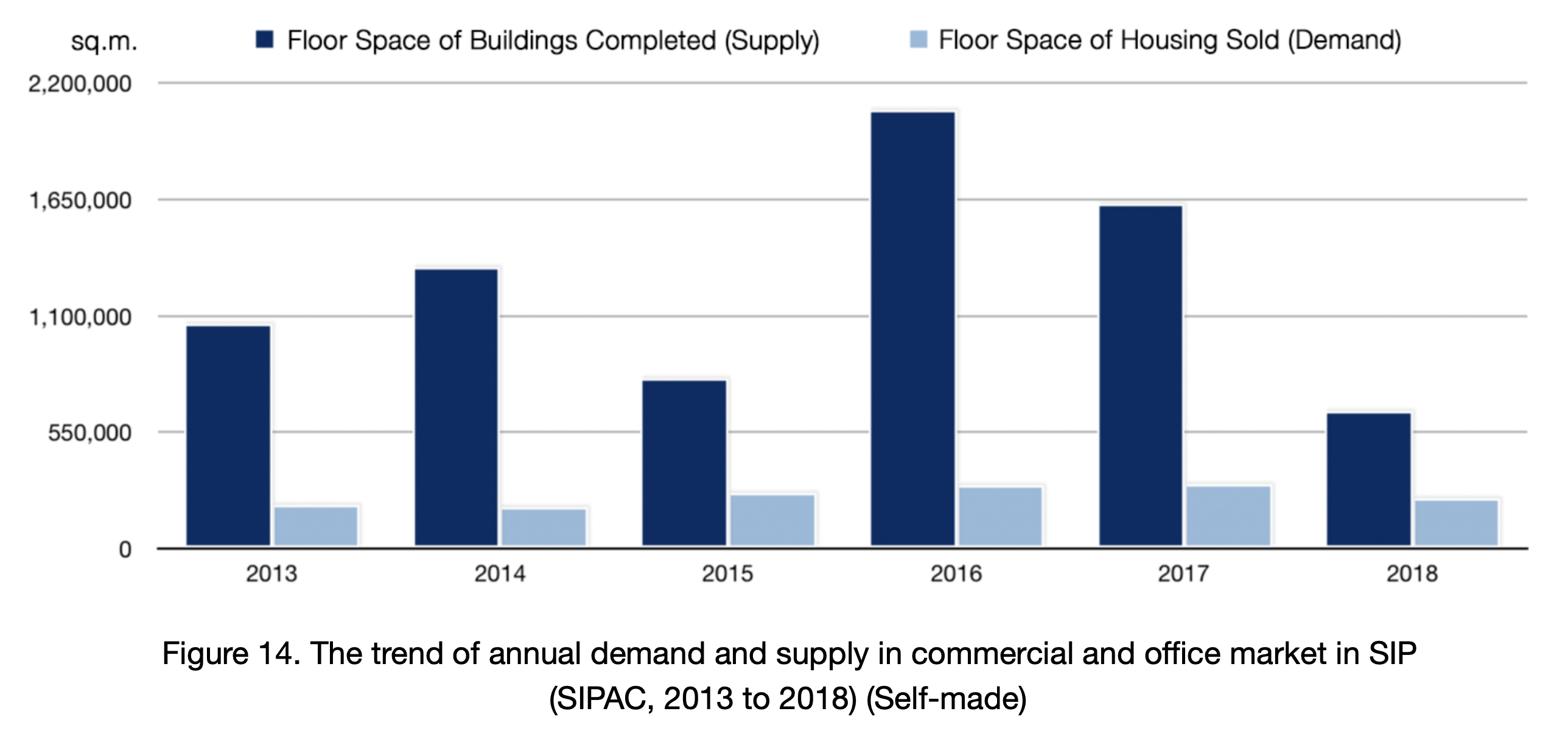
2.3 Market in Huxi CBD
Huxi CBD is the earliest developed area in SIP with a mature market. Due to the advantageous location, completed and qualified services and infrastructures, Huxi CBD has one of the highest property value in SIP (Figure 15). Even though the housing market is saturated in SIP, Huxi CBD will keep a favourable position in the market with an agglomeration effect. Compared with the potential competitors (Figure 16), China Vanke Co., Ltd., as a fortune 500 company, possess an apparent advantage.
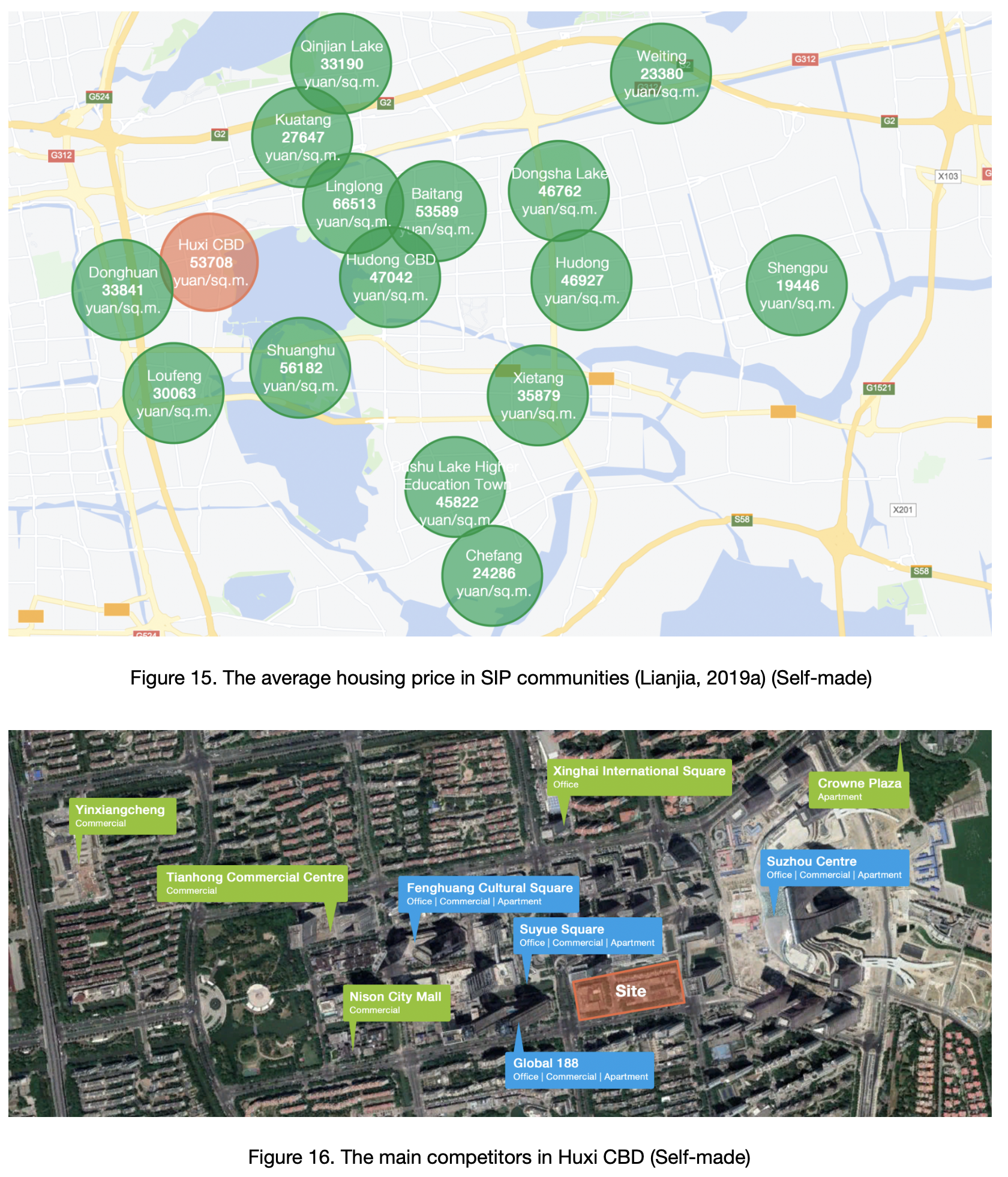
03 Project Strategic Context
3.1 Legal and regulatory analysis
Land Administration
- ‘Law of PRC on Land Administration’ states the regulations of land use in chapter 5 article 52 to 57 for construction companies conducting a specific construction project (NPC, 2004).
- Supplementary provisions are stated in chapter 5 article 21 to 24 in ‘Regulation on the Implementation of the Land Administration Law of PRC’ (The State Council, 1998).
- ‘Regulations of Jiangsu Province on Land Administration’ was published based on national law and regulation as supplementary (Jiangsu Provincial Department of Land Resources, 2000).
Construction Permit
- ‘Urban and Rural Planning Law of PRC’ states the regulations of construction permits in article 36 to 40 and article 43 (NPC, 2007a).
Real Estate
- ‘Law of PRC on the Administration of Urban Real Estate’ states the regulations of real estate development, transaction and ownership registration administration in chapter 3 to 5 (NPC, 1994).
- As supplementary, ‘Regulation on the Administration of Development and Operation of Urban Real Estate’ states the regulations of real estate development and operation in chapter 3 and 4 (The State Council, 2011).
- Real estate leasing and sales shall obey the rules of ‘Interim Regulations of PRC Concerning the Assignment and Transfer of the Right to the Use of the State-owned Land in the Urban Areas’ (The State Council, 1990).
- ‘Regulations on the Administration of Urban Real Estate Transactions in Jiangsu Province’ states the regulations of real estate transaction, mortgage and lease in chapter 2 to 4 (Jiangsu Provincial Department of Land Resources, 2002).
Environmental Protection
- ‘Law of PRC on Environmental Impact Assessment’ states that the construction companies shall prepare environmental impact assessment document before construction with the detailed information in chapter 3 (NPC, 2002).
- ‘Law of PRC on Conserving Energy’ stipulates the principles of building energy conservation during the whole development process in chapter 3 section 3 (NPC, 2007b).
- ‘Regulations on Green Building Development in Jiangsu Province’ states the rules of planning, design and construction in chapter 2, operation in chapter 3 and green building technology in chapter 4 (Jiangsu Provincial Department of Land Resources, 2015).
3.2 Planning appraisal
Key Documents:
- The general development requirements of 2018(02) land parcel are listed in Article 5 in ‘Transfer Instructions’ published by SIP Land and Environmental Protection Bureau (2018b).
- ‘The Planning Requirements of No.784 Land Parcel’ (Appendix A) published by SIP Planning and Construction Committee (2018a) is the key document to guide the planning of the proposed site. It provides the detailed principles of planning guidelines for different planning parameters.
- The supplementary document published by SIP Social Services Bureau (2017) states the planning requirements of community neighbourhood committee and age-friendly service facilities.
- The boundary map and detailed geographical information are provided by SIP Surveying, Mapping and Geoinformation Co., Ltd. (2017).
Other relative regulations:
- The proposal should meet the standard of 3-star green building for energy conservation and environmental protection. The reference document is ‘Green Building Evaluation Criteria’ (MOHURD, 2019). 3-star green buildings should meet the standard that the score of each category is more than 40 points and the total score is more than 80 points.
- It is required that the proportion of prefabricated construction area is 100%, and that of prefabricated single building is 30%. The reference documents are ‘Prefabricated Building Evaluation Standard’ (MOHURD, 2017a) and ‘Technical Standards for Prefabricated Steel Structure Construction’ (MOHURD, 2017b).
- Underground design should meet the requirements of ‘Underground Space Planning Requirements of SIP Rail Transit Line 1’ (SIP Planning and Construction Committee, 2018).
- The planning and design, transportation, civil air defence, fire control, environmental protection and seismic requirements shall comply with the national standards and the opinions of relevant administrative departments.
04 Development Proposal
4.1 Layout and Uses
Under the condition of meeting all the requirements, the total gross lettable area is designed as large as possible for higher returns. According to the market research results, serviced apartment is considered as development priority. SIP as a gathering centre of foreign capital, has attracted a large amount of talents and stimulated the demand of serviced apartments especially for foreigners. Then, office building is regarded as the development focus because of the agglomeration effect of the top companies in central business district. Finally, the commercial areas are arranged at the bottom of buildings for services. In addition, electric substation, community neighbourhood committee, age- friendly service facilities and underground parking area are planned as requirements. The detailed planning parameters are shown in Table 2 and the proposed layout is shown in Figure 17.
Explanatory Note:
- The height of commercial area is designed as 6 m, and the heights of office building and serviced apartment are designed as 4.2 m (SIP Planning and Construction Committee, 2018b).
- The construction area of underground motor vehicle parking is designed as 40㎡/per, and the area of non-motor vehicles is 1.8㎡/per (MOHURD, 2016a).
- ‘Technical Regulations on SIP Urban Planning and Management’ states that the building areas of spacial corridor and underground space are not calculated in FAR (SIP Planning and Construction Committee, 2011).
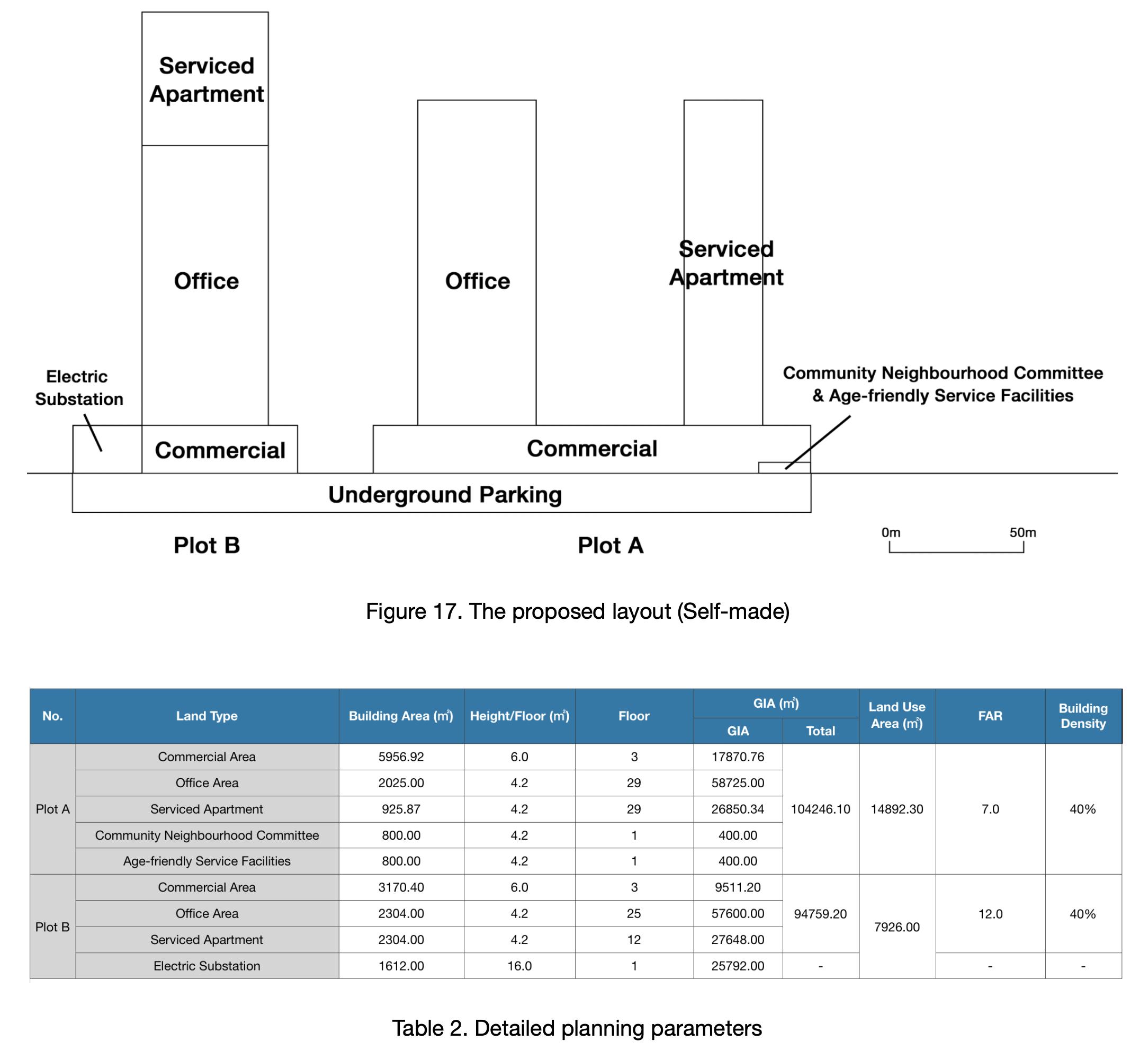
4.2 Operation Plan
According to the regulation, all commercial floor space shall be wholly owned by the developer, which cannot be sold or transferred in division. Therefore, the commercial areas are planned to be leased at market price in long term. The commercial centre should have a clear positioning and focus on brand building in order to achieve a stable development. The operating model can refer to the case of TaiKoo Li Sanlitun in Beijing (Anonymous, 2014). For office building and serviced apartment, the rental yields of them are lower than 5% (refer to section 5.1), which means it needs a long time to recover investment by leasing. However, it will also not be easy to sell completely in short term because of the high housing prize. Therefore, it is better to adopt the model of both sale and lease with selling first.
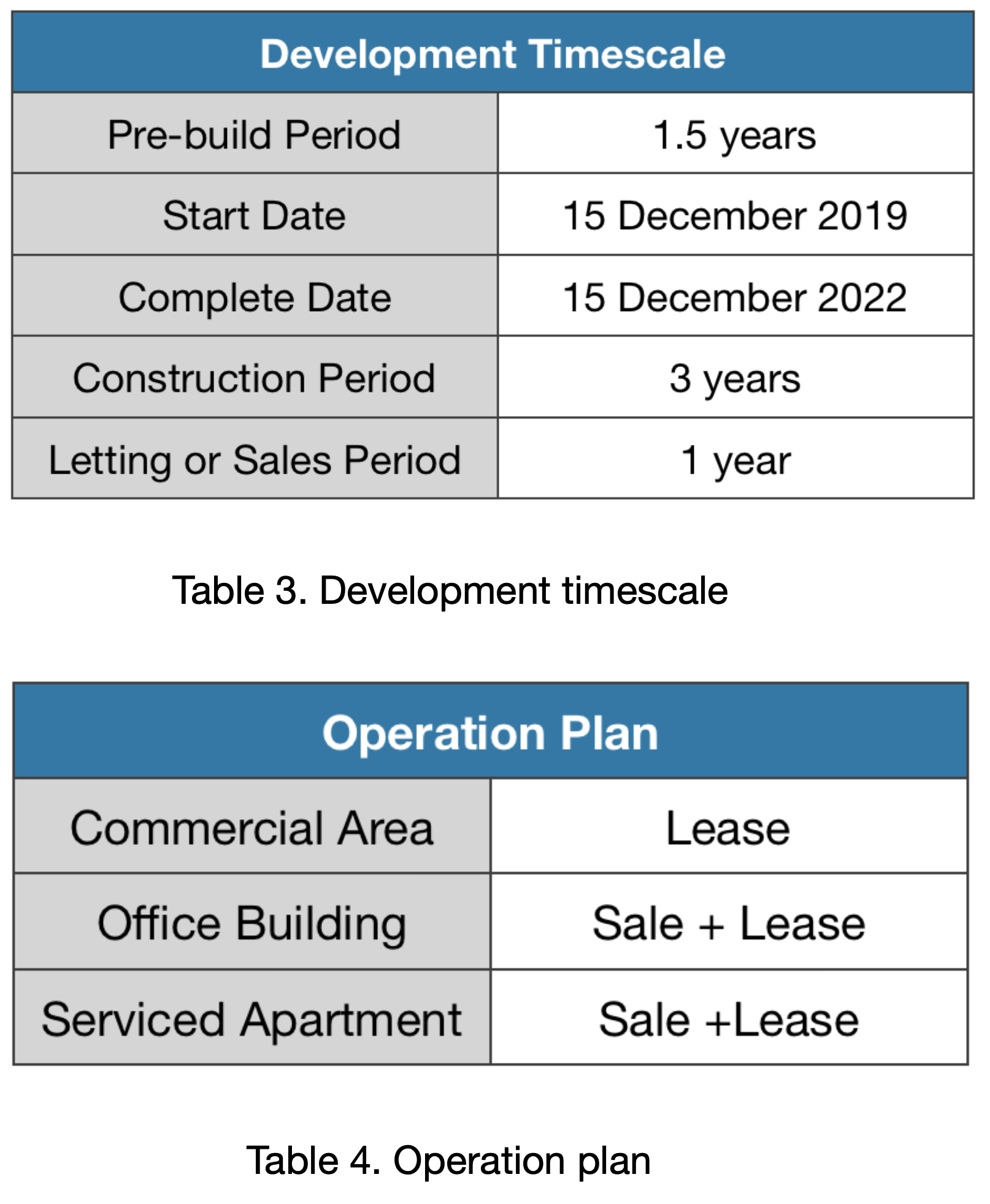
05 Financial and Socia-economic Analysis
5.1 Financial Appraisal (Table 5)
Residual method was used to calculate the developer’s profit based on the development proposal in Section 3. The key concept is that:
Developer’s Profit = Gross Development Value - Development Costs - Land Cost
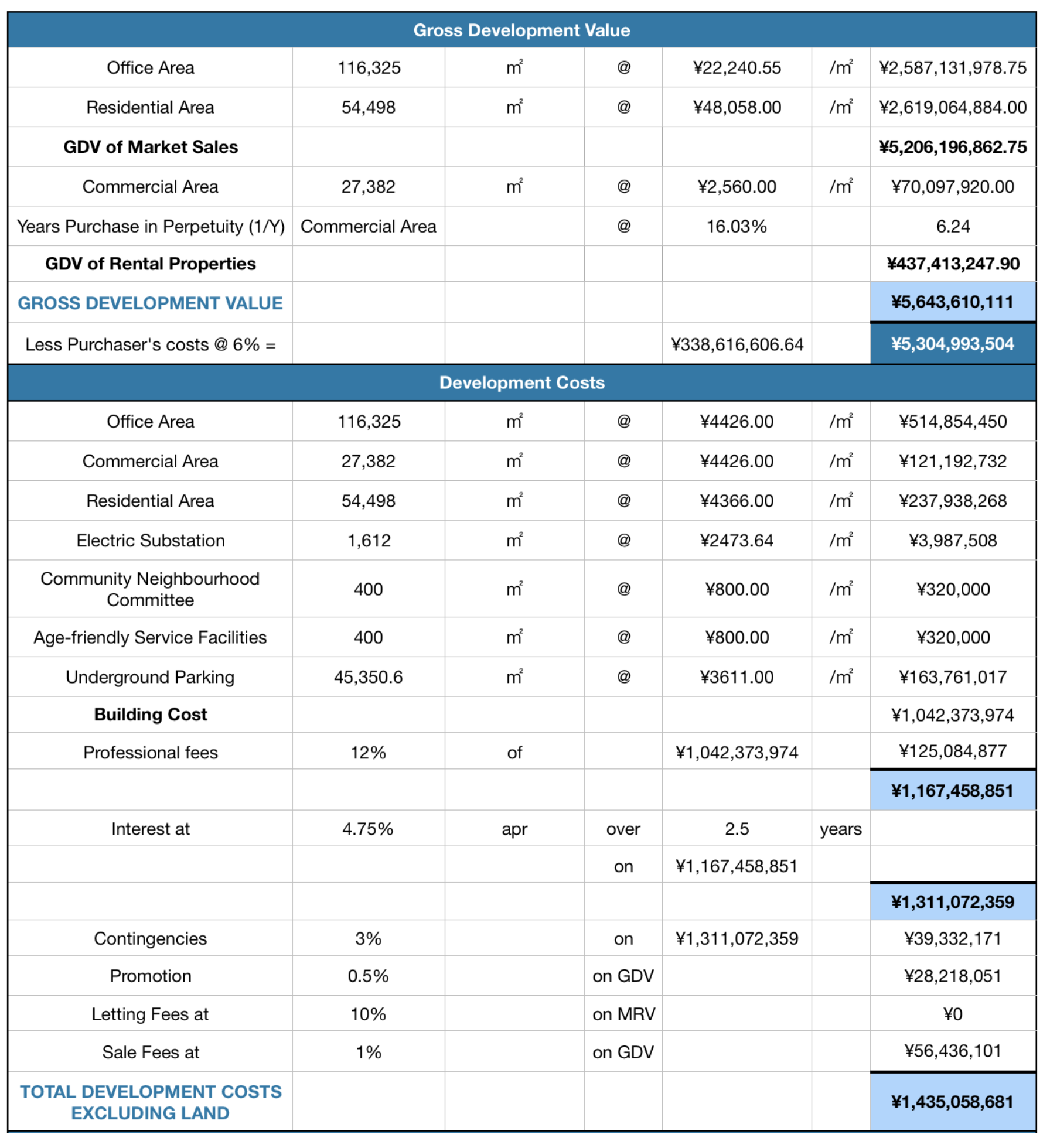
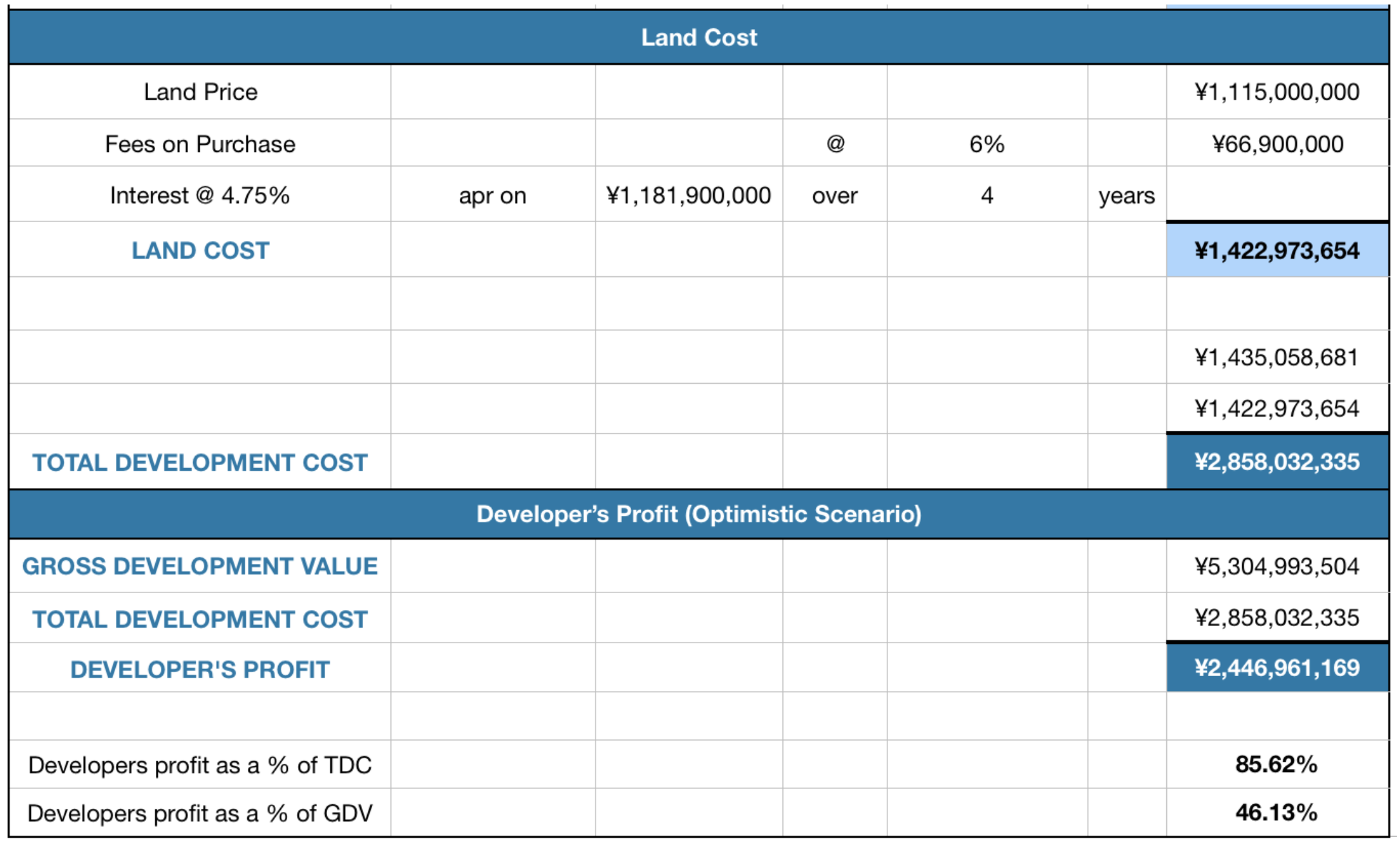
Assumptions:
- GIA is used as NIA because the national regulation states that: Area of Commodity Housing = House Architectural Area + Apportionment of Public Area (MOHURD, 1995).
- The sale price, rent and property management fee of office areas, commercial areas and serviced apartments are assumed by comparing with the most similar property in Huxi CBD (Table 6). The location and information of these properties are described in Section 2.3. The data was collected from Lianjia (2019b) and Fang (2019) (one of the biggest real estate agency in China) and the average price was calculated by author (Appendix B).
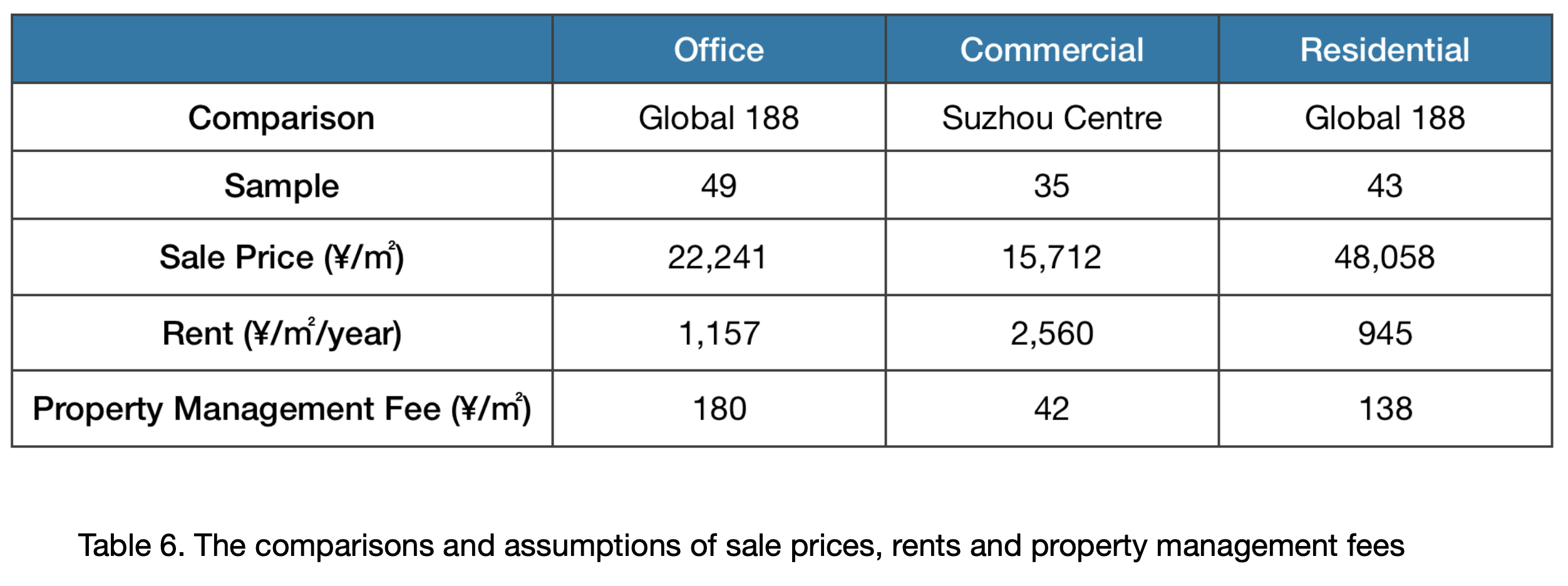
- Rental Yield = (Annual rental income - Annual expenses) / Total property cost *100% (Loan Market, 2019)
- Yield of Office Area = (¥1,157 - ¥180) / ¥22,241 = 4.39%
- Yield of Commercial Area = (¥2,560 - ¥42) / ¥15,712 = 16.03%
- Yield of Serviced Apartments = (¥945 - ¥204) / ¥48,058 = 1.68%
- Interest rate is assumed to be 4.75%, which is the rate of medium loan (3 - 5 years) in Bank of China (2015).
- Construction cost = Basic construction cost + Incremental cost of 3-star green building + Incremental cost of prefabricated building (Office, Commercial and Residential Areas)
- Basic construction cost is assumed to be ¥3,866 /㎡. It is the average cost of 45 similar development projects in Suzhou from 2014 to 2019. The data was collected from TGNET (2019) (building industry portal) and the average price was calculated by author (Appendix C).
- According to ‘Green Building Economic Indicators’ (MOHURD, 2019), the incremental costs of 3-star public and residential green buildings in Suzhou are ¥150-260 /㎡ and ¥120-200 /㎡ separately.
- According to national reference index of prefabricated construction project (MOHURD, 2016b) and the research of Xu and Wu (2019), the incremental cost of prefabricated building is assumed to be ¥300 /㎡.
- Construction Cost of Electric Substation is assumed to be ¥2473.64 /㎡, referring to an electric substation project in Shanghai (Anonymous, 2011).
- Construction Cost of Underground Parking is assumed to be ¥3,611 /㎡. It is the average cost of 5 similar projects in China. The data was collected from TGNET (2019) and the average price was calculated by author (Appendix C).
- Other assumptions (Chung, 2019):
- Cost of purchase is 6% (2% comprising legal fees and 4% stamp duty);
- Professional fees is 12% building costs (Architect 5%; Structural Engineer 2%; QS 2%; M&EE 1%; Project Manager 2%);
- Contingencies are 3% of running total;
- Promotion and marketing fees are 0.5% of GDV;
- Letting fees are 10% of MRV for sole agents;
- Sale fees are 1% of GDV for sole agents;
- Acquisition costs are 6% of land price (4% stamp duty; 1% agents fees; 1% legal costs).
5.2 Sensitivity analysis
5.2.1 Single-factor Sensitivity
The residual valuation conducted in Section 5.1 is based on many uncertain variables and assumptions. In order to reduce the risks in development process, the impact of changes in project variables should be investigated. Table 7 shows the changes of developer’s profit with the different scales of change of key influential factors. The red number shows the negative changes larger than 10%, which indicates that sales price of office building and serviced apartment, and construction cost are the most sensitive factors.
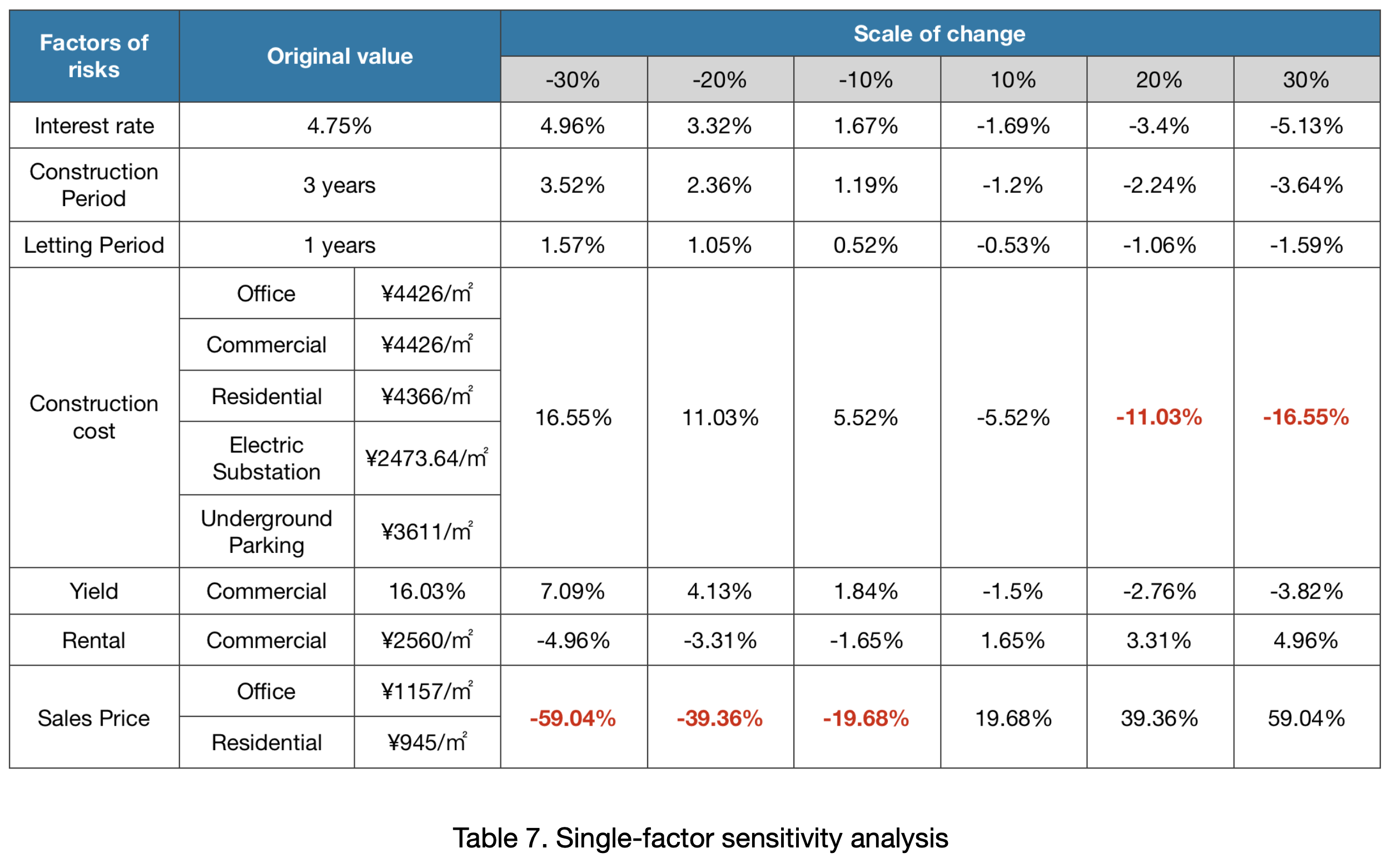
5.2.2 Optimistic Scenario
When all the variables are changed by 30% to reach an optimistic scenario, the developer’s profit will increase by 97.19% to ¥4,825,048,349, which is almost doubled.

5.2.3 Pessimistic Scenario
When all the variables are changed by 30% to reach a pessimistic scenario, the developer’s profit will decrease by 96.90% to ¥75,868,790, which is still making profits. The floating rate of 30% is an extremely negative situation, which hardly ever happens. It means that the project has a high risk resistance capacity.

06 Conclusion
In conclusion, the proposed site has huge development potential because of the advantageous location in Huxi CBD, even though the overall property markets in Suzhou and SIP have become saturated. Based on financial appraisal, the developer’s profit is ¥2,446,961,169, 85.62% of total development cost, which is a huge profit. According to sensitivity analysis, the anti-risk capability of the project is extremely strong. Therefore, the proposed development is viable and profitable to undertake.
References
Anonymous (2011) Index analysis of electric substation’s construction cost [online]. Available from: http://www.doc88.com/p-6781172427106.html (Accessed: 12 December 2019)
Anonymous (2014) “Sanlitun business district: TaiKoo Li business is hot while SOHO is cold”, Business View. [Online] Available from: http://news.winshang.com/html/026/5361.html (Accessed: 15 December 2019)
Bank of China (2015) Table of interest rate on RMB loans 2015-10-24. [Online] Available from: https://www.boc.cn/fimarkets/lilv/fd32/201510/t20151023_5824975.html (Accessed: 12 December 2019)
CEIC (2019) China Premium Database. [Online] Available from: https://insights-ceicdata-com.ez.xjtlu.edu.cn/Untitled-insight/views (Accessed: 23 October 2019)
CUTV (2018) “Service” for 14 years, the demolition of Zuo’an commercial street in SIP was completed. [Online] Available from: http://www.csztv.com/doc/2018/11/11/361943.shtml (Accessed: 10 December 2019)
Chung, H. (2019) Lecture notes from Planning and Property Development Module [Online]. Available from: Xi’an Jiaotong-Liverpool University ICE (Accessed: 10 December 2019)
China Index Academy (2019) Real estate policy in China in the first half of 2019. [Online] Available from: https://fdc.fang.com/report/12479.htm (Accessed: 23 October 2019)
Fang (2019) [Online] Available from: https://suzhou.fang.com/ (Accessed: 10 December 2019)
Jiangsu Provincial Department of Land Resources (2000) Regulations of Jiangsu Province on Land Administration, 014000060/2006-01370. Available from: Jiangsu Provincial Department of Natural Resources (Accessed: 15 December 2019)
Jiangsu Provincial Department of Land Resources (2002) Regulations on the Administration of Urban Real Estate Transactions in Jiangsu Province, 014000060/2006-01367. Available from: Jiangsu Provincial Department of Natural Resources (Accessed: 15 December 2019)
Jiangsu Provincial Department of Land Resources (2015) Regulations on Green Building Development in Jiangsu Province, 014000060/2015-03761. Available from: Jiangsu Provincial Department of Natural Resources (Accessed: 15 December 2019)
Lianjia (2019a) [Online] Available from: https://su.lianjia.com/fangjia/gongyeyuan/ (Accessed: 15 December 2019)
Lianjia (2019b) [Online] Available from: https://su.lianjia.com/ (Accessed: 10 December 2019)
Loan Market (2019) How to calculate rental yield. [Online] Available from: https://www.loanmarket.com.au/news/how-to-calculate-rental-yield (Accessed: 12 December 2019)
MOHURD (1995) Rules on calculation of commodity housing sales area and allocation of public building area, MOHURD No. [1995]517. Available from: MOHURD Online (Accessed: 15 December 2019)
MOHURD (2016a) Code for Urban Parking Planning, GB/T51149-2016. Available from: MOHURD Online (Accessed: 15 December 2019)
MOHURD (2016b) Consumption quota for prefabricated construction projects (Draft for comments), No. 919 [2016]. Available from: MOHURD Online (Accessed: 15 December 2019)
MOHURD (2017a) Prefabricated Building Evaluation Standard, GB/T51129-2017. Available from: MOHURD Online (Accessed: 15 December 2019)
MOHURD (2017b) Technical Standards for Prefabricated Steel Structure Construction, GB/ T51232-2016. Available from: MOHURD Online (Accessed: 15 December 2019)
MOHURD (2019) Green Building Evaluation Criteria, GB/T50378-2019. Available from: MOHURD Online (Accessed: 15 December 2019)
NPC (1994) Law of the People’s Republic of China on the Administration of Urban Real Estate, Order No. 29 (8th) of the President of the People’s Republic of China. Available from: Chinese Government Website (Accessed: 15 December 2019)
NPC (2002) Law of the People’s Republic of China on Environmental Impact Assessment, Order No. 77 (9th) of the President of the People’s Republic of China. Available from: Chinese Government Website (Accessed: 15 December 2019)
NPC (2004) Law of the People’s Republic of China on Land Administration, Order No. 28 (10th) of the President of the People’s Republic of China. Available from: Chinese Government Website (Accessed: 15 December 2019)
NPC (2007a) Urban and Rural Planning Law of the People’s Republic of China, Order No. 74 (10th) of the President of the People’s Republic of China. Available from: Chinese Government Website (Accessed: 15 December 2019)
NPC (2007b) Law of the People’s Republic of China on Conserving Energy, Order No. 77 (10th) of the President of the People’s Republic of China. Available from: Chinese Government Website (Accessed: 15 December 2019)
SIPAC (2013) SIP Monthly statistics (201312). [Online] Available from: http://www.sipac.gov.cn/government/tjsj/index_3.htm (Accessed: 10 December 2019)
SIPAC (2014) SIP Monthly statistics (201412). [Online] Available from: http://www.sipac.gov.cn/government/tjsj/index_2.htm (Accessed: 10 December 2019)
SIPAC (2015) SIP Monthly statistics (201512). [Online] Available from: http://www.sipac.gov.cn/government/tjsj/index_2.htm (Accessed: 10 December 2019)
SIPAC (2016) SIP Monthly statistics (201612). [Online] Available from: http://www.sipac.gov.cn/government/tjsj/index_1.htm (Accessed: 10 December 2019)
SIPAC (2017) SIP Monthly statistics (201712). [Online] Available from: http://www.sipac.gov.cn/government/tjsj/index_1.htm (Accessed: 10 December 2019)
SIPAC (2018) SIP Monthly statistics (201812). [Online] Available from: http://www.sipac.gov.cn/government/tjsj/index.htm (Accessed: 10 December 2019)
SIP Land and Environmental Protection Bureau (2018a) SIP land environmental protection bureau state-owned construction land use right online listing notice SIP land notice (2018) No. 02. [Online] Available from: http://jsyd.sipac.gov.cn/ggnrnew?crggId=0163615d80397d0379b061d12b7e0549 (Accessed: 8 December 2019)
SIP Land and Environmental Protection Bureau (2018b) 04 Transfer instructions. [Online] Available from: http://jsyd.sipac.gov.cn/view/resource/index?id=016361854ff97d0379b061d12b7e057d (Accessed: 8 December 2019)
SIP Planning and Construction Committee (2011) Technical Regulations on SIP Urban Planning and Management (2011 Edition), No. 01 [2011]. Available from: SIPAC Online (Accessed: 15 December 2019)
SIP Planning and Construction Committee (2018a) 06 The planning requirements of No.2 parcel. [Online] Available from: http://jsyd.sipac.gov.cn/view/resource/index?id=016361854ff97d0379b061d12b7e057d (Accessed: 8 December 2019)
SIP Planning and Construction Committee (2018b) Notice concerning the printing and distribution of technical provisions on planning and management of SIP (2011 edition) and the calculation of plot ratio in document SIP rules (No. 30 [2014]), No. 23 [2018]. Available from: SIPAC Online (Accessed: 15 December 2019)
Suzhou Press Conference (2017) This commercial street in SIP is going to say goodbye to Suzhou citizens! [Online] Available from: https://mp.weixin.qq.com/s/ ZQ3tA13Ysp9Sl6oi7zz3qg (Accessed: 10 December 2019)
Suzhou Statistics Bureau (2009) 2009 Suzhou statistical yearbook. [Online] Available from: http://www.sztjj.gov.cn/SztjjGzw/tjnj/2009/indexch.htm (Accessed: 23 October 2019)
Suzhou Statistics Bureau (2010) 2010 Suzhou statistical yearbook. [Online] Available from: http://www.sztjj.gov.cn/SztjjGzw/tjnj/2010/indexch.htm (Accessed: 23 October 2019)
Suzhou Statistics Bureau (2011) 2011 Suzhou statistical yearbook. [Online] Available from: http://www.sztjj.gov.cn/SztjjGzw/tjnj/2011/indexch.htm (Accessed: 23 October 2019)
Suzhou Statistics Bureau (2012) 2012 Suzhou statistical yearbook. [Online] Available from: http://www.sztjj.gov.cn/SztjjGzw/tjnj/2012/indexch.htm (Accessed: 23 October 2019)
Suzhou Statistics Bureau (2013) 2013 Suzhou statistical yearbook. [Online] Available from: http://www.sztjj.gov.cn/SztjjGzw/tjnj/2013/indexch.htm (Accessed: 23 October 2019)
Suzhou Statistics Bureau (2014) 2014 Suzhou statistical yearbook. [Online] Available from: http://www.sztjj.gov.cn/SztjjGzw/tjnj/2014/indexch.htm (Accessed: 23 October 2019
Suzhou Statistics Bureau (2015) 2015 Suzhou statistical yearbook. [Online] Available from: http://www.sztjj.gov.cn/SztjjGzw/tjnj/2015/indexch.htm (Accessed: 23 October 2019)
Suzhou Statistics Bureau (2016) 2016 Suzhou statistical yearbook. [Online] Available from: http://www.sztjj.gov.cn/SztjjGzw/tjnj/2016/indexch.htm (Accessed: 23 October 2019)
Suzhou Statistics Bureau (2017) 2017 Suzhou statistical yearbook. [Online] Available from: http://www.sztjj.gov.cn/SztjjGzw/tjnj/2017/indexch.htm (Accessed: 23 October 2019)
Suzhou Statistics Bureau (2018) 2018 Suzhou statistical yearbook. [Online] Available from: http://www.sztjj.gov.cn/SztjjGzw/tjnj/2018/indexch.htm (Accessed: 23 October 2019)
SIP Surveying, Mapping and Geoinformation Co., Ltd. (2017) 08 The boundary map and geographical information of No.2 parcel. [Online] Available from: http://jsyd.sipac.gov.cn/ view/resource/index?id=016361854ff97d0379b061d12b7e057d (Accessed: 8 December 2019)
SIP Social Services Bureau (2017) 07 The planning requirements of community facilities in No.2 parcel. [Online] Available from: http://jsyd.sipac.gov.cn/view/resource/index? id=016361854ff97d0379b061d12b7e057d (Accessed: 8 December 2019) TGNET (2019) [Online] Available from: http://su.p.tgnet.com/2.1.9/00020005/ (Accessed: 12 December 2019)
The State Council (1990) Interim Regulations of PRC Concerning the Assignment and Transfer of the Right to the Use of the State-owned Land in the Urban Areas, Order No. 55 of the State Council of the People’s Republic of China. Available from: Chinese Government Website (Accessed: 15 December 2019)
The State Council (1998) Regulation on the Implementation of the Land Administration Law of the Peoples Republic of China, Order No. 256 of the State Council of the People’s Republic of China. Available from: Chinese Government Website (Accessed: 15 December 2019)
The State Council (2011) Regulation on the Administration of Development and Operation of Urban Real Estate, Order No. 248 of the State Council of the People’s Republic of China, revised by the Order No. 588 of the State Council. Available from: Chinese Government Website (Accessed: 15 December 2019)
Xu, Y. G. And Wu, Y. B. (2019) ‘Study on incremental cost allocation of prefabricated buildings’, Friends of Accounting, (15), pp.11-16. [Online] Available from: http://www.wanfangdata.com.cn/details/detail.do?_type=perio&id=kjzy201915003 (Accessed: 12 December 2019)